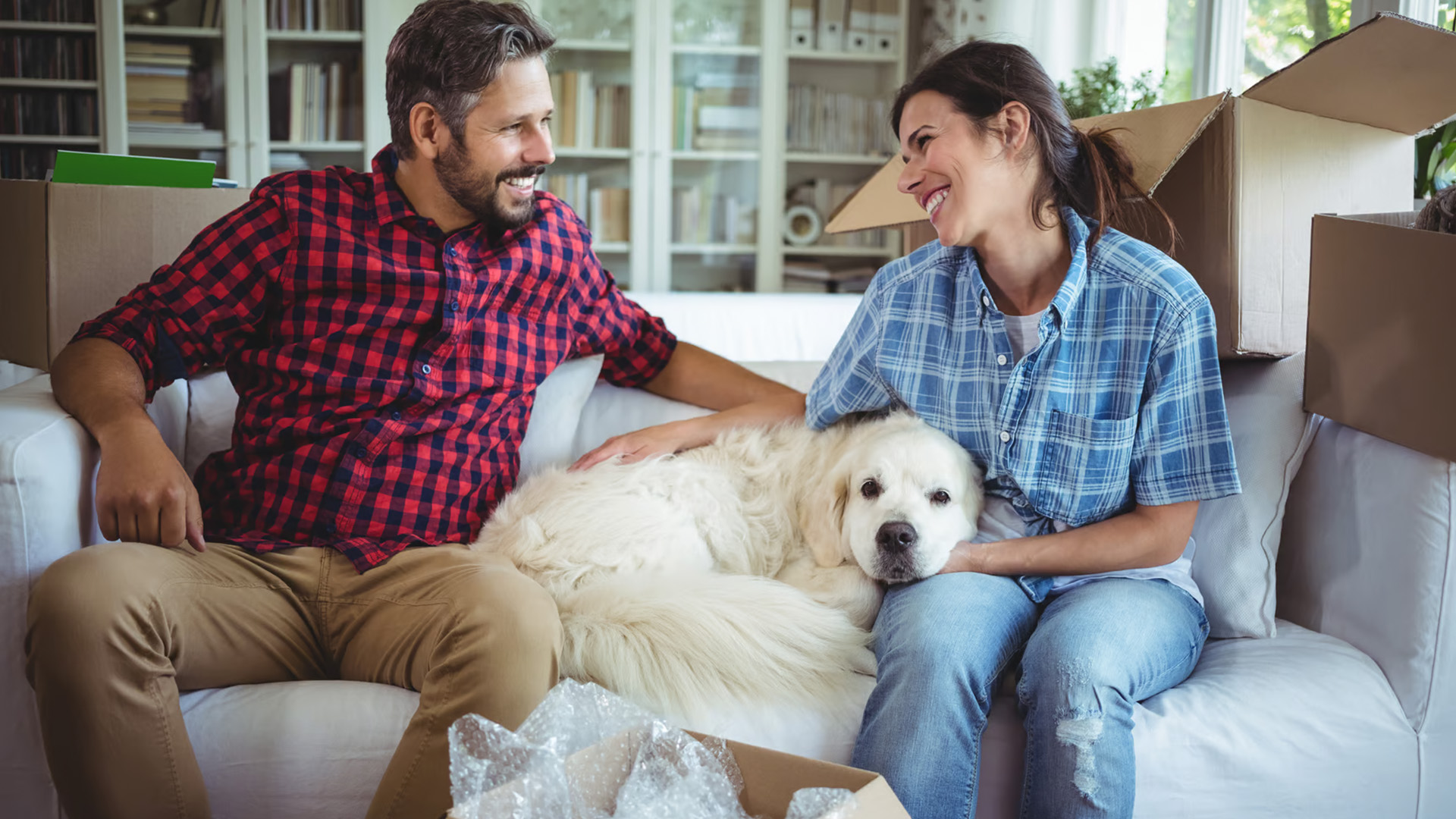Posted on
April 28, 2025
by
REMAX Crown Real Estate
Sharing a home with pets brings a blend of joy, companionship and responsibility – whether that home is large or small, freehold or condo.
Congratulations on your move! By now, you know that some extra planning helped make it a smooth one for you and your furry friend(s). Now comes the fun part – life in your new home. Life with pets comes with some unique considerations. From shedding to elevator etiquette, Pet Valu's Animal Care Experts share some best practices and tips for living your best life, with pets in tow.
The truth about shedding
Even the most devoted pet lovers would agree that shedding isn’t exactly a perk. One moment, your home is spotless, and the next, fur has taken over. It clings to furniture, covers your clothes, and somehow settles on surfaces your pet hasn’t even touched. Shedding is a natural and necessary process that helps dogs and cats maintain a healthy coat. Some pets shed lightly year-round, while others seem to unleash a fur storm when the seasons change.
It allows them to remove dead or damaged hair, make room for new growth, and regulate their body temperature. Shedding helps distribute natural skin oils, which keep the coat moisturized and protect against irritation. It can be influenced by factors such as breed, health conditions, diet, stress, and living environment. While some pets shed more than others, all animals with fur experience some level of natural hair loss.
NON-SHEDDING PETS
While no pet is completely shed-free (aside from the un-furred variety), some breeds naturally shed much less than others. These low-shedding breeds are often referred to as hypoallergenic because they produce less airborne pet dander, a common allergen that can trigger reactions in sensitive individuals. Popular low-shedding dog breeds include the Bichon Frise, Portuguese Water Dog, Soft-Coated Wheaten Terrier, Schnauzer, and Poodle—along with many Poodle mixes known for their reduced shedding. A common misconception is that all Doodle mixes (like Labradoodles and Goldendoodles) are non-shedding, but this isn’t always the case. Since these breeds are crossbred, some inherit more shedding traits from their non-Poodle parent. Keep in mind that coat type can vary even within the same litter.
For cat lovers, low-shedding breeds include the Devon Rex, Cornish Rex, Siberian, and Bengal. These breeds tend to have finer, shorter, or curlier coats that shed less than the typical feline.
WHEN IS IT A PROBLEM?
Shedding is an essential biological process that helps pets maintain a healthy coat. While it is natural, excessive hair loss or bald spots can indicate an underlying health issue. A pet’s coat is often a reflection of their overall well-being, so sudden or severe hair loss should never be ignored. If your pet is experiencing bald patches, thinning fur, red or inflamed skin, excessive itching or an unusual odour, there may be a deeper issue at play.
Common causes of abnormal shedding include allergies, parasites (like fleas and mites), poor nutrition, endocrine disorders (such as thyroid disease) and stress. Shedding can also be a sign of more serious conditions, such as autoimmune diseases or cancer.
If shedding is accompanied by weight loss, lethargy, or changes in appetite, a veterinary check-up is strongly recommended.
How to minimize shedding
Although shedding cannot be completely stopped, Pet Valu emphasizes that pet owners can take proactive steps to reduce fur loss and maintain their pet’s coat health.
Grooming
Regular grooming is one of the best ways to manage shedding. Brushing and bathing help remove loose fur before it falls onto furniture and clothing. Using the correct grooming tools for your pet’s specific coat type is key. Some pets benefit from daily brushing, while others only need grooming a few times per week. Watch out for changes in skin and coat health during grooming sessions can help detect early signs of problems.
Diet and Hydration
A nutrient-rich diet with omega fatty acids (such as those found in fish oil) can help strengthen hair follicles, reduce excessive shedding, and promote a shinier, healthier coat. Hydration is equally important—well-hydrated skin is less likely to become dry or irritated, which can lead to increased hair loss.
Managing Stress-Related Shedding
Stress can cause pets to shed more than usual. This is because stress triggers the release of hormones that cause sudden hair loss. Many pet owners notice this when taking their pet to the veterinarian, during travel, or in unfamiliar environments. The good news is that stress-induced shedding is usually temporary—once the pet is calm, the excessive shedding stops. To help reduce stress, pet owners can provide a stable routine, a safe and comfortable environment, and positive reinforcement during stressful situations.
Essential cleaning hacks
There is a particular type of chaos that comes with owning a pet. Between shedding, muddy paw prints, and the occasional accident, keeping your space fresh with a pet around takes a little extra effort. With the right habits and tools, you can stay ahead of the mess without spending hours cleaning. We teamed up with Pet Valu to bring you the best pet cleaning hacks, along with expert-approved tips to make cleaning up after your pet as easy as possible.
Say Goodbye to Stubborn Carpet Stains and Odours
Accidents happen, and when they do, having the right cleaning supplies can make all the difference. Pet Valu recommends keeping a pet stain remover on hand. Enzyme-based cleaners work best since they break down the proteins that cause stains and odours. If you don’t have one, a 1:1 mix of vinegar and water can also help neutralize smells. For fresh stains, blot, but don’t rub to avoid pushing the mess deeper into the carpet. If you’re dealing with an older stain, Pet Valu suggests using a steam carpet cleaner to lift it from deep within the fibres. To keep carpets smelling fresh between cleanings, sprinkle baking soda on the area, let it sit for 15 minutes, then vacuum it up.
Keep Your Pet’s Bed Fresh and Clean
A pet bed can be a hot spot for fur, dirt, and odours if not cleaned regularly. Pet Valu encourages vacuuming pet beds before washing them to remove excess fur. This prevents buildup in your machine and keeps pet hair from sticking to your laundry. For best results, spot clean as needed and wash the bed at least once a month with a pet-safe detergent. And don’t forget, keeping your pet well-groomed means less dirt and dander ending up in their bed (and around your home).
Keep Muddy Paws Out of Your Home
Pets have a talent for tracking dirt and mud inside, turning clean floors into a mess in seconds.Here are two simple solutions: have your pet wear booties for an easy, no-mess option, or train them to pause at the door for a quick wipe-down with pet wipes or a towel before stepping inside. If booties aren’t an option, keeping a shallow container of water by the door can make rinsing muddy paws easier. Teaching your pet to “give a paw” before coming inside is a great way to reinforce good habits and keep your floors cleaner. To protect entryways and keep floors from getting damaged over time, place a washable mat at the door and use rugs in high-traffic areas.
Stop Fur and Dander from Taking Over Your Home
Pet hair and dander can build up fast, but staying ahead of it makes all the difference. Regular brushing removes loose fur before it ends up on your furniture, clothes and floors. If your pet isn’t a fan of brushing, introduce it slowly with treats and positive reinforcement. A HEPA air purifier can also help trap pet hair and dander in the air, making it a great investment for allergy sufferers. Combine regular grooming, vacuuming, and air filtration, and you’ll have a cleaner, healthier home for both you and your pet.
Maximizing small spaces
If you’ve ever lived in a small space with a pet, you know the struggle is real. Between their toys, bedding and feeding stations, it can sometimes feel like your home belongs more to them than to you. Finding that sweet spot between making your pet feel at home and keeping your space livable isn’t always easy. But don’t worry; here are some tips and clever tricks to help you maximize your space without sacrificing style, comfort or your sanity.
Dedicated Pet Zones
A smart setup keeps your home tidy and your space feeling like yours not just your pet's playground. Set up food and water bowls in a consistent, low-traffic spot near the kitchen, which is ideal for easy refills. Place beds in quiet spots where your pet can relax undisturbed. Keep toys organized in baskets, bins or furniture with built-in storage. Choose options that match your home's aesthetic.
Vertical Space
When floor space is limited, go vertical. Install cat shelves, trees or wall-mounted climbing units to expand their territory. A window hammock is perfect for lounging while keeping the floor clear. Look for pet beds with built-in storage, or consider ottomans and benches that double as cozy pet retreats. These space-saving solutions keep your home looking neat while maximizing every inch.
Take it Outside
The outdoors is your pup's playground! Start by taking short walks, letting them sniff and explore at their own pace. Always bring poop bags to clean up after your pet, along with some treats for rewards or training. Look for nearby parks, walking trails, or pet-friendly stores where your pet can stretch their legs and socialize.
Protect Your Home's Value
While pet-friendly homes can be cozy and welcoming, untreated stains, odours, and excessive fur buildup can lead to long-term damage that may lower the value of your home. Carpets that have absorbed years of pet accidents, scratched hardwood floors, and lingering pet odours can all become costly issues when it’s time to sell or renovate. Here are a few helpful tips:
Trim your pet’s nails regularly to reduce scratches on hardwood floors and furniture.
Seal and protect flooring with a scratch-resistant coating, or choose durable, pet-friendly materials like vinyl, laminate, or tile to minimize wear and tear over time.
Invest in pet-safe scratch guards for doors and walls to prevent claw marks.
Use washable, stain-resistant paint on walls to make cleaning up pet smudges, dirt, and fur buildup easier.
Invest in furniture covers to prevent fur and dirt from embedding into upholstery. These are easy to wash and swap out when needed.
Ventilate your home regularly to keep pet-related odours from settling into fabrics and walls.
More Resources…



















